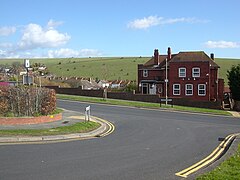Woodingdean
| Woodingdean | |
|---|---|
 Cowley Drive, at the south end of Woodingdean |
|
| Population | 9,793 (2011.Ward) |
| Unitary authority | |
| Ceremonial county | |
| Region | |
| Country | England |
| Sovereign state | United Kingdom |
| Post town | BRIGHTON |
| Postcode district | BN2 |
| Dialling code | 01273 |
| Police | Sussex |
| Fire | East Sussex |
| Ambulance | South East Coast |
| EU Parliament | South East England |
| UK Parliament | |
Coordinates: 50°49′41″N 0°04′19″W / 50.828°N 0.072°W
Woodingdean is an eastern suburb of the city of Brighton and Hove, East Sussex, separated from the main part of the city by downland and the Brighton Racecourse.
The place takes its name from a former farm at the southern end of the modern suburb, whose main claims to fame are to have been owned by the comedian Max Miller and used as a wartime retreat by the former emperor of Ethiopia, Haile Selassie. The site of the main house is now Ovingdean Close, Ovingdean, and converted farm buildings remain in Ovingdean Road.
The earliest buildings in Woodingdean apart from scattered farm buildings were those of the former workhouse school in Warren Road, whose site is now a private hospital - The Nuffield. This contains the capped site of what is still, after 150 years, claimed to be the deepest hand-dug well in the world. Hand-dug between 1858 and 1862, its depth is 1,285 feet (392 m).
Woodingdean in its present form began to grow up after the First World War in the northern part of the parish of Rottingdean. It consisted of plots of land on the South Downs which had formerly been used for sheep-farming. These were sold by developers (often but not exclusively to returning soldiers) and most were originally smallholdings, e.g. poultry farms.
The development of the present residential area very much mirrors that of neighbouring Ovingdean. From the 1920s building plots were sold off and first generation shacks and houses began to appear. The area was once locally notorious, like nearby Peacehaven, for the shacks that were put up on these plots, whose architectural styles ranged from Wooden Hut to Railway Carriage Body. Life in these plotlands was satirized in a stage play by H. F. Maltby called What Might Happen (1927). In 1928, both Woodingdean and Ovingdean became part of Brighton County Borough, a move which heralded a substantial increase in residential development.
...
Wikipedia
